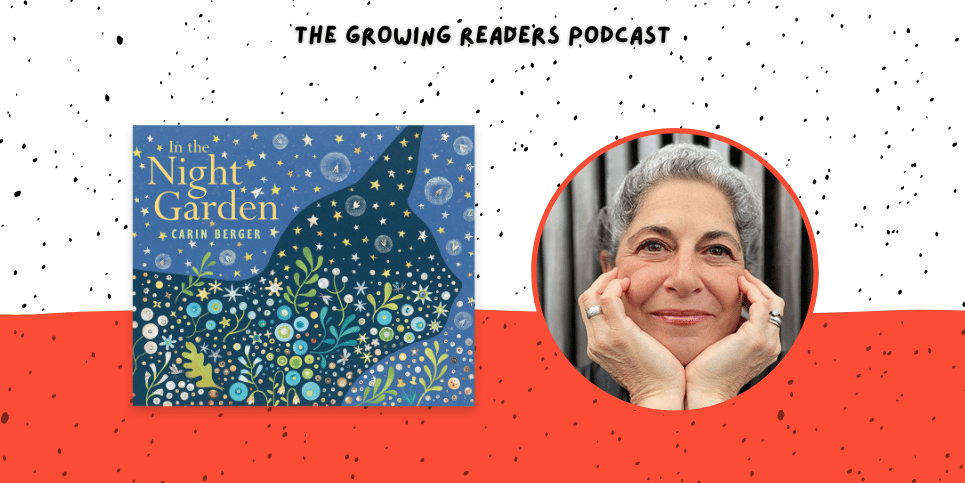A podcast interview with Carin Berger
The Children’s Book Review
In this episode of The Growing Readers Podcast, listeners will have the chance to learn about award-winning author-illustrator Carin Berger, her love for books, childhood memories, and the inspiration behind her latest book, In The Night Garden.
The picture book presents itself as a gentle, collage-illustrated bedtime read that explores the often mysterious yet beautiful experiences that take place in nighttime spaces. Carin kindly discusses her creative process for creating collages, showcasing her expertise in producing such intricate artwork. She also delves into the impact she hopes In The Night Garden will have on its readers, inviting listeners to indulge in this fantastic piece of children’s literature.
Listen to the Interview
The Growing Readers Podcast is available on all major platforms. Subscribe Now.
Read the Interview
Bianca Schulze
Having you on the show today is such a full circle moment for me because back in 2009, we recorded an in-person interview in beautiful Point Reyes, California because I had this lofty dream of starting a podcast. So, I quickly listened to that recording yesterday, and the sound of the birds in the background was insane.
Carin Berger
I totally remember that. Yeah.
Bianca Schulze
Well, I mean, it was amazing, but it was almost really hard to, uh, even hear us talk. So, I am just really thrilled that I think it’s, like, twelve years later that I finally had this podcast come to fruition and to have you in an opportunity to really be able to hear you talk. So, thanks for being here.
Carin Berger
It’s so delightful. Yeah. We’ve known each other for a long time. It was nice that it launched in person, and then it’s so nice. It’s been such a nice connection.
Bianca Schulze
Yeah, exactly. Well, I want to start with a question that is a common one that I ask. And it’s to be a writer. Some people say that you need to be a reader first. So, I would like to know, was there a pivotal moment in which you considered yourself a reader?
Carin Berger
I think since tiny-hood, I’ve always loved books. I’ve loved them as objects. I’ve loved them as just the form of a book. And even as a really little kid, we’d go to the library once a week, and we each were allowed to, I don’t know, get a little pile of books. So, I’ve always been a reader. I don’t think I’ve always actively thought of I may not even still think of myself as a writer. I don’t think I would introduce myself as a writer. And that’s just because even though I’ve always written, that’s not my training. My training is in design and in art.
Bianca Schulze
Do you have any favorite childhood memories with books or a specific book?
Carin Berger
Well, a couple of things. My uncle, I have this uncle that I really love, who as a kid, I mean, I was really little, used to send me books from he’d travel. And he’d send me books, um, from different places in the world. And I still have those. They’re still some of my favorite little treasured objects that I have kept. So, I remember, as a kid, just that magic of feeling like something traveled from far away to me and seemed exotic and new and other.
Bianca Schulze
Yeah, I love that. Well, since it has been a while since we had our last in-depth conversation, we’ve had a lot of little emails here and there, but it’s been a long time since we talked about creating books and how you create books. So, I want to know what has kept you motivated and what guides you in creating books for children right now.
Carin Berger
Wow. Well, to be honest, um, each book becomes its own discrete, um, problem. When I finish a book, I almost can’t imagine starting another one. So, it doesn’t feel like—and when I go to start a book, I can often not remember how to do it because it’s such a crazy long process that I almost feel like I’m starting new each time and don’t necessarily have I don’t know. It’s almost like each book is its own individual design problem or conceptual problem, or psychological knot that I’m trying to untangle.
And before we started talking, I think that there is a running idea that still feels important to me. And that is, I think if you dig down, most of my books somehow touch on community and connection and friendship. Um, and that’s just a thing that I feel like is buzzing around in my head as an important thing, particularly right now with these challenging and divisive times. So, I think that might be the arc that carries through a little bit.
Bianca Schulze
Yeah, absolutely. And another theme that I notice is just the natural world that almost always takes place in your artwork and your books. So where did your love for the natural world stem from?
Carin Berger
Well, my mom was, uh, an elementary school art teacher and also a very outdoorsy person. So, we spent a lot of time camping and being outside. And I think I find it a very centering, sort of, it kind of puts everything back into perspective that we’re not the center, that there’s all this other stuff going on in the world. So, like, I forage for mushrooms, and I garden, and I and I find those things kind of connecting and sort of, um, important in terms of grounding myself.
Bianca Schulze
So, what’s something that you like to do when you need to clear your head and focus on creating a book? I have to imagine you like to get outside.
Carin Berger
Yes, I walk. I tend to walk every day. Sometimes I walk alone; sometimes I walk with friends. And when we’re, um, upstate in our house, we have a little house upstate that we’ll talk about, but I garden. It becomes a very Zen, kind of, like, meditative thing where I realize, like, I’m working ideas out. I think I’m procrastinating, and perhaps I am, but I also find it’s a time to clear my head and think things through. And that’s a very, um, productive, creative time.
Bianca Schulze
Yeah. So, your latest block, In the Night Garden, explores the natural world during nighttime. Will you talk us through what readers can expect?
Carin Berger
Sure. So, on its face, it’s really, quite simply a book about exploring or understanding what goes on outside at night when we’re not there sometimes. And so, there’s a black cat that kind of escorts you through the garden at night, and there’s different sounds, and it’s sort of sensory in all kinds of different ways, looking and hearing and, um, ah, touching.
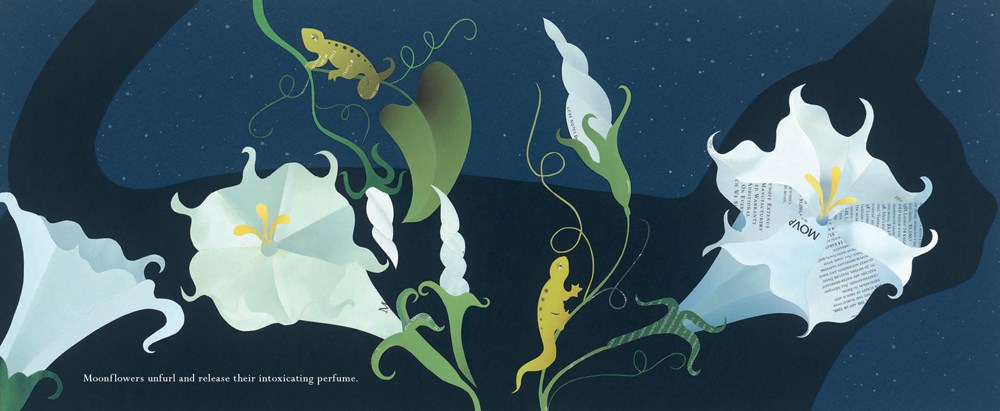
And then I am hoping that on a deeper level, my daughter was a little bit afraid at night and not so good at falling asleep, um, particularly in new places. So, when we got our house, we would lie outside—the sounds were different than the city sounds, and we would lie out on the porch at night and kind of look at the stars and identify the sounds. So, the book, on a deeper level, I’m hoping, um, touches on being open and curious and unafraid about things we don’t know, or people that we don’t know, or cultures or the unknown. And so that’s, maybe most people won’t go there, but I’m hoping that some people will use that as an opportunity for conversation about that.
Bianca Schulze
Yes. Well, I know that you have a great love for gardening, and you just talked about how you enjoy foraging for mushrooms. So, I have to imagine that the gardening part was a massive part of the inspiration for this book. And is that a fair assumption?
Carin Berger
Yeah, gardening and also just where we live, we’re surrounded by eleven acres. Well, we have eleven acres, and then we’re surrounded by an Audubon bird preserve that’s 1000 acres. So, there’s a lot of woods; there’s a lot of, a lot of the things in the book came from little, tiny experiences I’ve had, like seeing fox cubs playing in the stream or having a hood owl up in our apple tree looking down at me while I was gardening. So yes, ah, books tend to be pretty personal, really, when you pare it down.
Bianca Schulze
Yes. Well, let’s talk about the cat because it’s a lot about the garden and the night and the curiosities that we see when we’re outside. And it’s not necessarily through the eyes of the cat, but it kind of also is. So, talk to me about the cat, the inspiration for this specific cat, and what you think the cat feels as it goes through the book.
Carin Berger
That’s so interesting. Yeah. Um, well, the cat is really a tribute to my daughter’s cat, Cozy—Cosette from Les Mis. Thea was obsessed with Les Mis. So yes, Cosette was a rescue cat that Thea got as a sort of little support animal when she started college. I’ve never had a cat. I have a bunny. She had a bunny growing up. My husband’s allergic to cats, but her cat used to come home in the summer and live with us and the bunny, and they’re fascinating because they have very, well, at least her cat has this very strong clarity that I find interesting.
So, the cat in the book is a tribute to Cozy, but it’s also, uh, perhaps like a kind, all-seen voice. You know, she’s the narrator in this story, even though she’s not sort of the loud narrator. I think of it as her voice and her shepherding you through the garden and saying, well, look at this. They’re nocturnal. I guess that’s what I have to say about the cat.
Bianca Schulze
I love that you described her as not a loud narrator because there’s a lot where you hear people who are maybe trying to get a book published, and they get the feedback that, well, this is too quiet for a picture book. And I love that. I actually think the cat is a quiet narrator. And that is what brings some of the beauty to your book.
Because sometimes, if you’re out in nature, if you are being loud and busy, you’re not going to catch what nature is trying to show you. And so having this quiet cat sort of gracefully move through the night, obviously a picture book, the only sounds you’re going to hear are the sounds in your head or the sounds of the grown-up reading it to you. And I think because she is a quiet narrator, we get to actually take in and have the sensory experience of what your artwork is showing us and what your words are telling us. I love that you said that.
Carin Berger
Yeah. Thank you. She’s your guide.
Bianca Schulze
Yes. And she’s a beautiful guide. So, you create your artwork with cut paper to make collages, and each piece is handmade with found ephemera. Will you share your process with us, including how you find the just right scraps of paper and materials? How long does each piece take you?
Carin Berger
Okay.
Bianca Schulze
I wish everyone could see your face right now.
Carin Berger
Well, I’m cringing because it’s the least efficient process one could ever invent. And my background is in graphic. My training is in graphic design. I’ve designed exhibitions and identities and brochures and all this, um, annual reports and books. That’s my background. And I was like the last batch of students to learn to do stuff by hand. I was just on the cusp of the computer being introduced. And so, as everything moved more and more digital, I started really missing working with my hands. So, I guess I would preface it with that.
And so, my artwork is almost a response to that, but it’s definitely a really slow process. I draw very intricate dummies. And then I make vellums, which are translucent paper, which are very tight drawings like they’re a map. And then I cut stencils out. I’m sort of mortified to describe this. Um, so I cut stencils out of vellum, and then I place it over my collection of paper. So, if I know I want to have, like, a black cat, but I want sort of highlights along her edge. I’m looking through this hole to find that perfect place, and then I cut her out. And I may cut, like, five cats before I’m like, this is the cat for that page. So, sitting on my desk might be all these tiny little crazy pieces of rejects.
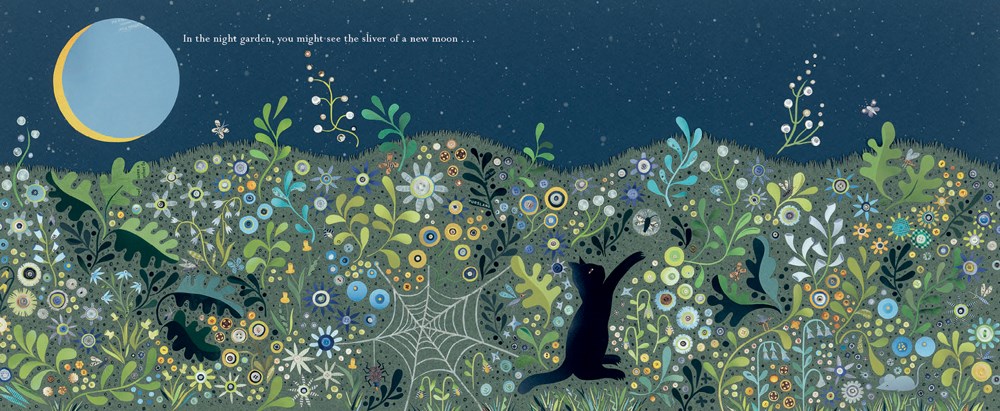
And then I just use really; it’s all really rudimentary materials. It’s old ephemera. So, I collect stuff, and I love that they come with these stories built in. So, some of them are really old, from the 18 hundreds, and they’re ledger books from an old grocery store. Some of them are letters. And again, I just love the poignancy of them having this kind of mystery of where they came from. And then some of them are J. Crew catalogs, which, unfortunately, J. Crew has stopped making them, or magazines or something that I find on the street that just has a good number on it.
I’m not a hoarder, but I’m a bit of a collector of things, an archivist. Um, so, yeah, I don’t know if that answers—and then I just use scissors and an exacto knife and white glue, like we all have in our house, perhaps. And it’s very rudimentary in that way.
Bianca Schulze
Yeah, I love it. So, it’s something just because of the way you make your collages; I think it can bring parents or any caregiver that’s reading your book with their kid just an opportunity to keep coming back to it because it’s really fun to look at the tiny little scraps that have made something larger. And I don’t know if it’s just me, but I’m always, like, looking. I’m like, Carin must have a secret message in here. Why did she pick this specific piece of paper? What does this number mean? And why these little words on this little leaf? I don’t know. Do you want to give away any secrets that we could look for in the night garden?
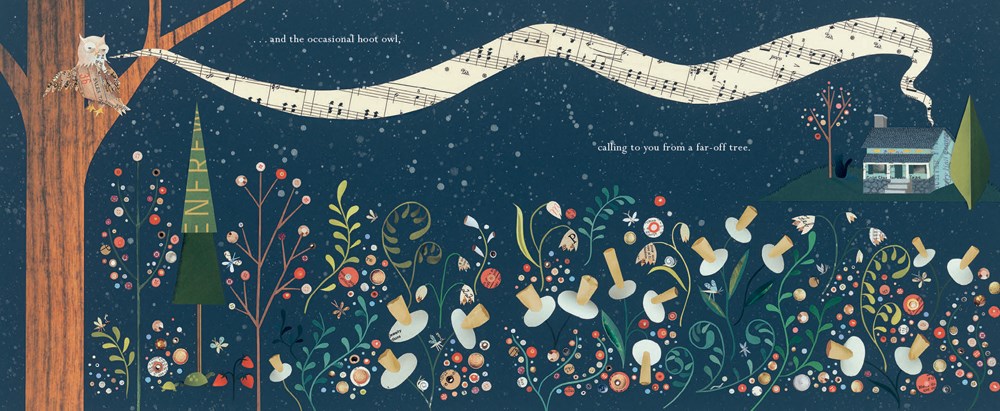
Carin Berger
Sure. They’re often quite intentional. I don’t have a book. Should have a book in front of me. I don’t. Um, well, one thing that’s always in every single one of my books is Thea, my daughter’s name. T-H-E-A So, um, there was an artist, Al Hirschfeld, when I was little, and he had a daughter named Nina. So, he would do these wonderful ink calligraphic ink drawings, and there would be a number down by his signature, like three or six. And that was how many Ninas were hidden in the calligraphic lines of his drawing. And as a kid, I don’t know. I just loved that.
So, Thea’s name is somewhere in each and every one of my books. And there’s often teas or things like that. And then sometimes there’s just something that I like, like California or where we met or, um, something that resonates a word that kind of resonates. I mean, sometimes it’s random, or sometimes it has to do with where the paper came from, which has meaning to me, but nothing to offer you. But there’s reasons why I’m choosing what I’m choosing.
Bianca Schulze
Yeah, I feel like it just comes across like you just know when you’re looking at a page that there’s more meaning to it than meets the eye.
Carin Berger
Oh, I love that. That’s so nice to hear. Yeah.
Bianca Schulze
Well, let’s talk about some specific spreads. Do you have any favorites?
Carin Berger
It’s kind of like asking if you have a favorite child. I mean, each spread kind of has its own resonance for me. So I don’t think I have a favorite spread per se. I think, um, there is one of the houses, and that’s our house, so that’s kind of nice to have.
Bianca Schulze
And that’s your house in the Hudson Valley, right?
Carin Berger
Yes. It’s an old, like, 1860s, very small little farmhouse.
Bianca Schulze
I definitely need to spend some more time poring over the pages, but I just think I love the way the silhouette of the black cat is just so subtle on your choice of the blue backgrounds. I don’t know. I just love looking for the cat and looking at the cat, and I don’t know, she’s just kind of slinky and curious and gentle, and yeah, I just think I love looking at the cat throughout.
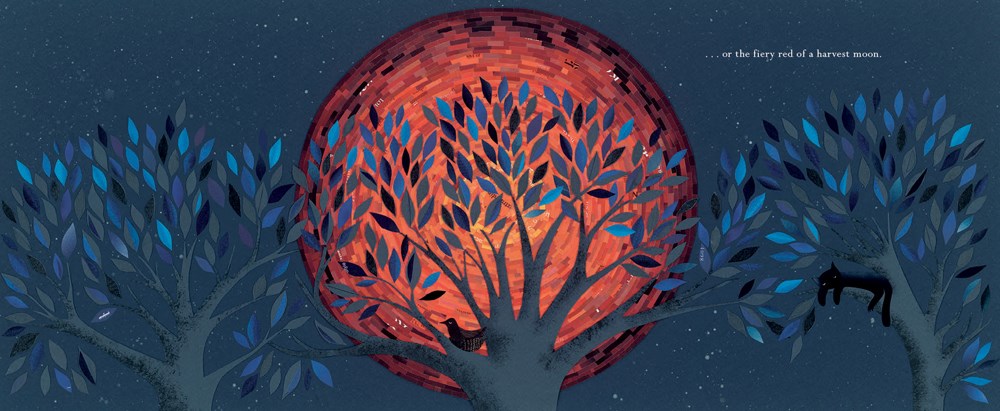
Carin Berger
There is a picture book. I don’t even think I have it. And I can’t even remember the author. But when I was little, there was a book about—it was about nighttime, and it was blue and black. It was a more vivid blue than maybe I used, but most of the book was blue and black. And then, you would open the page, and it would show you the daytime version that was all these colors. But there’s something about that blue and black like the almost; I don’t know. I do like that.
Bianca Schulze
What do you use for the backgrounds on your artwork?
Carin Berger
Yeah. Well, this won’t resonate with anybody, probably, but it used to be when you would make in graphic design when you would make your, um, mockup of your design, there were these papers called Pantone Papers, and they’re very matte, and there’s, like, thousands of colors. You were picking a specific color. So, of course, computers have gone out of business in that way, but, uh, there was an art store closing out and selling all their remnants, and I bought them all, so I use that a lot.
But now I have a fairly limited color palette left of all the yucky colors. We don’t necessarily want to use them, but I use those. And then now I’ve been using, I just look for a very flat I don’t want a texture, usually on the surface, but then I do add paint and texture to the surface, but I don’t want a bumpy surface. So, there’s Japanese papers I sometimes get.
Well, anyway, and then when you have your artwork all finished.
Bianca Schulze
I imagine that editors and art book designers nowadays, with all the digital work coming in, that’s probably pretty quick and exact. But we need all sorts of artwork. So, I’m not discounting digital work here. But to have your artwork where we know somebody has painstakingly cut out and put it together, how do you get that to your editor and to the art designer? And how does that all work?
Carin Berger
Yeah, I play a real role because of my design background, I’m used to the printing process, so I’m very involved in that end of things.
It’s kind of crazy these days because it gets shipped. So, I bring the actual artwork in all tenderly packaged up, and we go through it, and we make notes, and then we send it—the publisher sends it to China, and then they scan it. Um, but they can’t—this is maybe too technical. They have to do it flat because the art is very delicate, so they can’t wrap it around a drum or something. They have to scan it as a flat thing. And then, they send back color-correct proofs to correct the color. And we go back and forth.
So, the art travels to and from China, like, four or five times, which is kind of insane, right? I don’t think about it that much, but yeah.
And then, for this book and most of my books, it was important to me to print on uncoded paper. So not shiny paper, but you’ll feel the paper is uncoded. And, um, I like that because it’s a very classical feel like that’s what picture books usually used to be. And I like the touch in the hand. But it’s difficult to print subtle colors like the blue and the black we were discussing and get all those delicate tonal details right on an uncoated paper because it’s like a sponge. It absorbs your ink and pulls it away from the surface. So, I had to kind of talk the publisher into doing that.
And we got our first round of proofs on both coded and uncoded. And, of course, it looked much better on the coded paper at first pass. So, it was a bit of a process going back and forth and checking it against the art and pushing the printer to get things the way we needed them to be. But yeah, it’s kind of crazy.
Bianca Schulze
Well-traveled, and all that hard work has definitely paid off. So, you already touched on this. But just in a nutshell, what impact do you hope that In the Night Garden has on readers?
Carin Berger
Yeah, well, I’m glad that you’re asking it again because I think, on the face, it’s a good night book, right? It’s sort of a nighttime night story. So, I guess I just really do hope that the message of facing the unknown isn’t so buried that it doesn’t get noticed. I hope that comes through somehow.
Bianca Schulze
And are you working on anything else?
Carin Berger
I am. Do you know who Rachel Vail is? She’s an author. She does a lot of YA books, but also some picture books, and she lives four floors up from me, just coincidentally. So, she’s my walking partner, and she has a pet tortoise, and I have a pet rabbit. So, for the last ten years, we’ve been joking that we should do a book about tort and hare. And so, we’re working on an early reader series about friendship and about tort and hair. She’s a very accomplished, wonderful writer with a lot of humor and emotional intelligence, and nuance.
Bianca Schulze
It’s so fun that you both live just so close and to be able to collaborate like that. I love that.
Carin Berger
I know.
Bianca Schulze
So, if listeners were to take away one thing today from our discussion, what would you want that to be?
Carin Berger
Oh, golly. Um, I guess just to look deeply when you’re out in the world and looking at books. Yeah. I find that to be a very meaningful part of my life.
Bianca Schulze
I love that. And just the way you said that, so simply too. It’s beautiful. Well, Carin, it’s been so lovely to chat with you voice-to-voice once again.
Carin Berger
Almost face to face.
Bianca Schulze
In the Night Garden is so stunning, and I know that it will encourage those who read it to be open and curious about being outside and enjoying it outdoors during the night, too. So, thank you so much for just coming and sharing your process and your heart with us today. It’s been an absolute pleasure.
Carin Berger
Thank you so much for having me. I am such a fan of yours and your work, so thank you.
Bianca Schulze
You’re making me blush.
Carin Berger
You’re making me blush.
The transcription has been lightly edited for readability.
About the Book
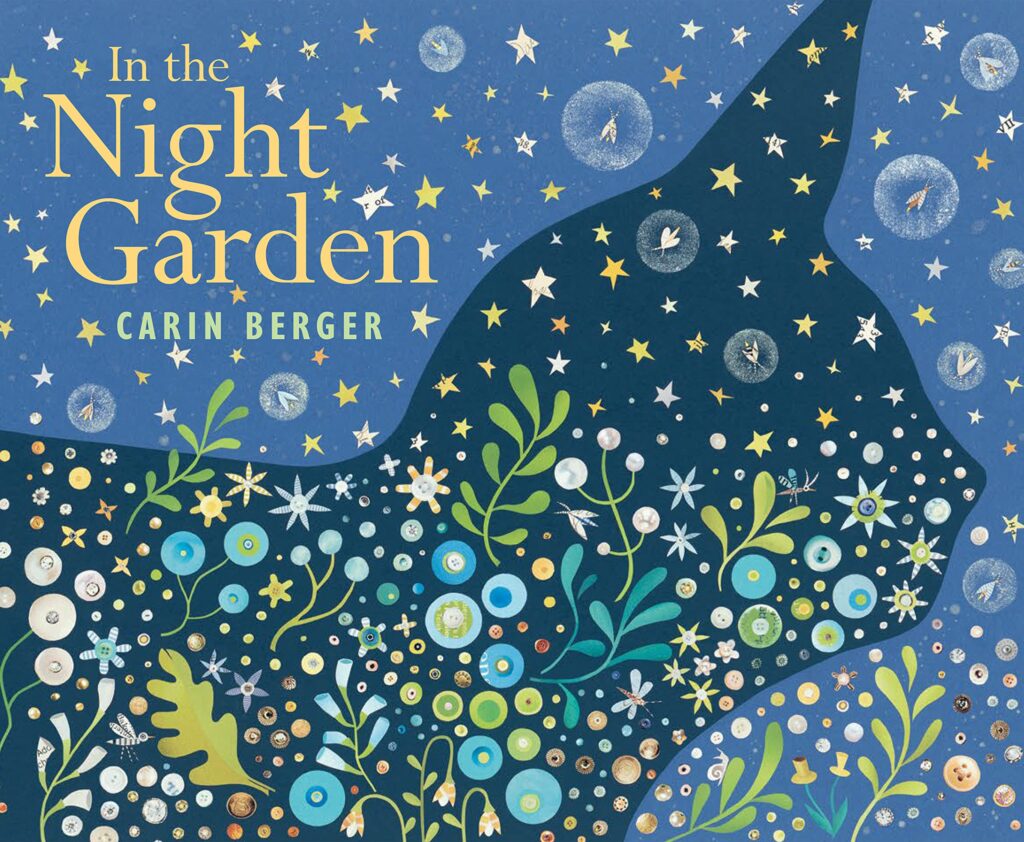
In the Night Garden
Written and Illustrated by Carin Berger
Ages 3+ | 40 Pages
Publisher: Neal Porter Books | ISBN-13: 9780823449866
Publisher’s Book Summary: A gentle, collage-illustrated bedtime read about the often mysterious and always beautiful experiences to be found in nighttime spaces.
In the night garden fireflies look like fallen stars.
Moonflowers unfurl and release their intoxicating perfume.
In the night garden you can lie
on the cool grass and look up to the
millions and trillions of stars…
In the night garden, nothing is as it seems and everything is made new. Blinking stars and pale moonlight might reveal a lone cat tiptoeing across a roof, luminous flowers unfurling in the cool air, a mama fox escorting her sleepy cubs home. Listen closely and you might hear the wind blowing through the trees, the murmur of a slow stream, or the gentle song of crickets and bullfrogs, lulling you to sleep.
Carin Berger is the award-winning author of The Little Yellow Leaf, a New York Times Best Illustrated Book. With soothing words and spectacularly detailed, hand-cut collage artwork, she has fashioned a bedtime book like no other. Curious readers will be rewarded when they look for the mysterious cat that appears on every page!
Buy the Book
Show Notes
Resources:
You can visit Carin Berger at http://www.carinberger.com/.
Discussion Topics:
- Carin’s motivations for creating books for children
- Exploring the natural world at night and overcoming fears
- The process of creating collages, which involves drawing intricate dummies, making vellums, cutting stencils, and using found ephemera
- The hidden messages or secrets in the artwork—Carin sometimes incorporates words or numbers with personal significance
- Getting the physical artwork to editors and art designers and the back-and-forth process of scanning and color correction
- Challenges of printing on uncoated paper
- The impact Carin hopes her book In the Night Garden will have on readers
- Encouragement to look deeply at books and the world around you
Thank you for listening to the Growing Readers Podcast episode: Carin Berger Talks About Her Stunning New Picture Book ‘In the Night Garden’. For the latest episodes from The Growing Readers Podcast, Follow Now on Spotify.

